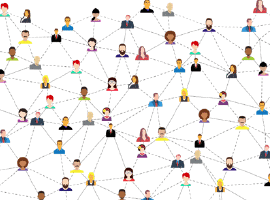Let’s face it, email isn’t bad for communication, but when we make it the vehicle where all of the work happens things start to get out of hand. It happens to me throughout the day. This quick poll on Twitter tells me I’m not the only one who want’s to work less in email.
#Poll : How do you keep up to date with work stuff? #Friday
— Yaroslav Pentsarskyy (@spentsarsky) November 17, 2017
The issue
So why does this happen that our mailboxes often become workflow, document management, collaboration, sharing, notification, and reminder tool. Well, it’s what we are most familiar with, it’s handy, so we try to use it for everything. Email is also super easy, free, and you don’t need any extra apps.
The side effect of using an email is that any processes we have worked into it are most likely only known to us making the knowledge locked inside our heads. This isn’t usually a problem until you get overwhelmed and need to scale or delegate parts of that manual process.
Email messages along with other communication are pieces of puzzles that form a cohesive picture, whether it’s a request, or a task. Relying on email alone will give you the granularity, but won’t give you the big picture at quick a glance. It’s easier to miss a hidden context related to a timeline for example.
The more email we have the harder it is to separate distinct strains of processes buried deep in your mailbox.
To make sense how to deal with the issue we classified the types of emails we often get …
Types of email
We looked at the most common types of emails landing in our mailboxes to see how we can deal with them. Here is what we found:
QUICK ASK
This is direct request and something we can answer quickly. We don’t need to do research, dig some data, ask anyone else, or go through documents. This can also be a meeting request, something we can easily accept or decline.
What happens: These usually get responded to “right away” or as soon as you’re free from whatever else you’re doing.
FYI
No response required, not urgent enough to read it now but something we want to go back to maybe today or tomorrow. This can be work related or external like a webinar we want to watch.
What happens: This typically sits in our mailboxes for few hours to few days, to few weeks depending how busy we are.
TASK
This is basically an assignment someone has given us whether they realize it or not. Often disguised as “quick question” but actually has no a quick answer. It can also be an automated alert we need to action. For this we need to go back and do some research before we can answer. Now the part between someone giving us a task and us responding to that email is a “black box”, sometimes no-one knows what happens.
What happens: This can be a dreadful one, it can turn into quite some work. These emails usually sit and wait and often can turn into more emails to other team members, a meeting or a document etc. The requestor can wait for days or sometimes weeks to an answer.
How to better deal with them?
Apart from a task-type-email other are easy to deal with. However, there are things we can do to improve the situation:
LOTS OF “QUICK ASKS”
Things you can do:
- Setting up a knowledge base with FAQ’s on your intranet
- Sharing responsibilities, even if it’s part time
- Enabling self-serve: creating quick-steps-sheet or video
- Organize Lunch and Learn
QUICK ASKS OFTEN TURN INTO TASKS
This means people don’t understand the full picture or there are missed expectations. The drawback of this is that people don’t really understand what you’re doing and think that it’s not a significant request, where in fact it is.
Things you can do:
- Clarify the request to make sure you understand it correctly
- Try to find a mutually convenient workaround to reduce the size of the task
- Track the task in a tracker tool such as Planner or Trello
Here is an example of tracking editorial calendar so that you can see everything that goes into writing and what’s outstanding, the deadlines, and dependencies

tracking editorial calendar
TOO MANY FYI’S
This means people may not be clear about the process and over-communicate to cover all the bases. This may also indicate that people don’t have a place to talk or engage.
Things you can do:
- Document and communicate the process if those FYI’s are related to process or work
- Set up a News & Events area on your intranet with comments, if those FYI’s are related to general company communication
DEALING WITH TASKS
The key to dealing with tasks is tracking. Just as shown above, for a simple editorial process you may end up with dozens of little tasks. No need to keep them spread around in your email folders. Same applies to your sales and marketing pipeline, your support requests. Tracking will ensure you keep you promises while remaining sane and not drowning in a flood of email.
Below is an example of on-boarding view where your team members responsible for on-boarding can easily see the process and execute it if required in your absence.

example of on-boarding view
Another step further is automating some of the activities with workflow tools like Zapier or Flow. For example, using our on-boarding example, you can automate electronic contracts or offer letter signing and filing directly into SharePoint without using any code with Flow or Zapier. This will eliminate at least 2 or 3 emails for each of the participants and keep documents securely stored and accessible by those who need to see them.
Using these techniques we were able to significantly reduce the amount of interruptions our team gets daily and keep on track with our deliverables providing visibly better service.
How are you using email and what are things you’re thinking about automating? We’d love to hear from you.
Yaroslav Pentsarskyy is the founder of OrigamiConnect, a rapidly growing service and product offering which enables organizations to get an intranet designed for them without starting from a blank page. He’s also 8 time Microsoft MVP, speaker at many local and worldwide tech events, and a published author of several SharePoint related books.
Reference:
Pentsarskyy, Y. (2017). How To: Work less [in] your email. [online] Origami Connect: SharePoint intranet in-a-box for Office 365 and on-prem. Available at: https://www.origamiconnect.com/blog/working-less-in-your-email [Accessed 16 Jan. 2018].











